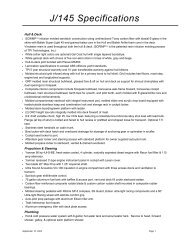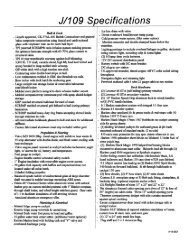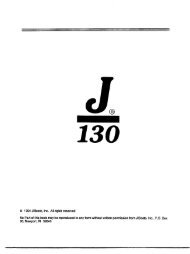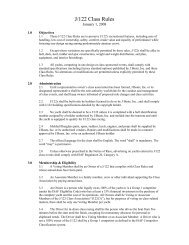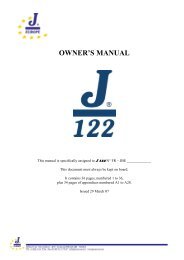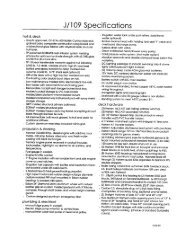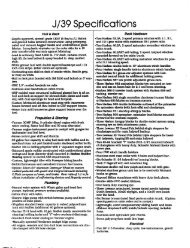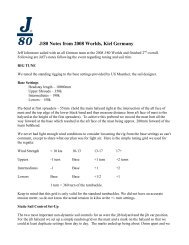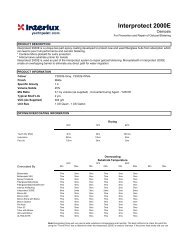J105 Owner Manual 2012.pdf - J/Owners
J105 Owner Manual 2012.pdf - J/Owners
J105 Owner Manual 2012.pdf - J/Owners
Create successful ePaper yourself
Turn your PDF publications into a flip-book with our unique Google optimized e-Paper software.
J/105 <strong>Owner</strong> Guide ...................................................................................................................................................................................................................................................... 31 <br />
6. Once the engine starts, set the throttle at about 1,000 RPM. If all engine indications are <br />
normal, warm up the engine for 10 minutes. <br />
7. Briefly test the operation of FORWARD and REVERSE gears at the dock with the dock lines <br />
in place. <br />
CAUTION: If the engine does not start after a pro-‐longed period (do not exceed 10 seconds at a <br />
time) of cranking, be sure to drain the water-‐lock muffler and exhaust loop. ACCUMULATED WATER <br />
IN THE MUFFLER MAY FLOW BACK INTO THE ENGINE MANIFOLD AND DAMAGE THE ENGINE IF THE <br />
MOTOR IS CRANKED FOR A PRO-‐LONGED PERIOD AND DOES NOT START. <br />
IMPORTANT: Check that a flow of raw-‐water cooling water is exiting from the transom. If cooling <br />
water is not being discharged, the engine will overheat: shut down the engine immediately. <br />
Check that the raw-‐water strainer basket is free of blockage. Check that the raw-‐water engine-intake<br />
valve is open on the seacock. If necessary, check underneath the hull to make sure that the <br />
raw-‐water intake seacock is not blocked. <br />
Shutting Down The Engine <br />
1. Move the throttle to the IDLE (vertical) position. <br />
2. Run the engine at IDLE long enough to allow the engine to cool down. <br />
3. Push the button on the engine instrument panel until engine stops. <br />
4. When the engine-‐alarm sounds, turn the key OFF. <br />
IMPORTANT: Do not use the ignition key to shut down the engine. Do not stop the engine with <br />
the decompression levers except in an extreme emergency. If decompression lever is used to <br />
shut down the engine, fuel will spray out and accumulate on top of pistons, creating a danger of <br />
explosion the next time engine is started. <br />
Fueling <br />
When taking on fuel, follow these safety precautions: <br />
1. Secure your boat to the dock using bow, stern, and spring lines. <br />
2. Turn OFF all mechanical and electrical equipment, including the engine, battery selector <br />
switch, cabin lights, and electronics. <br />
3. Remove the fuel-‐fill deck plate plug; clean the threads of both the plug and deck plate so <br />
that no dirt falls into the filler opening. Place the fuel hose nozzle into the fill pipe. <br />
4. Fill the fuel tank slowly. Do not overfill the tank. Because marine fuel expands with an <br />
increase in temperature, fill the 18-‐gallon tank to only 95% of its capacity. If you cannot <br />
see the fuel pump, ask the attendant or a crew member to call out the total gallons. <br />
IMPORTANT: If the fuel tank is overfilled, fuel will leak out the tank vent located on the <br />
transom. Be ready to contain and clean up any spillage immediately.



